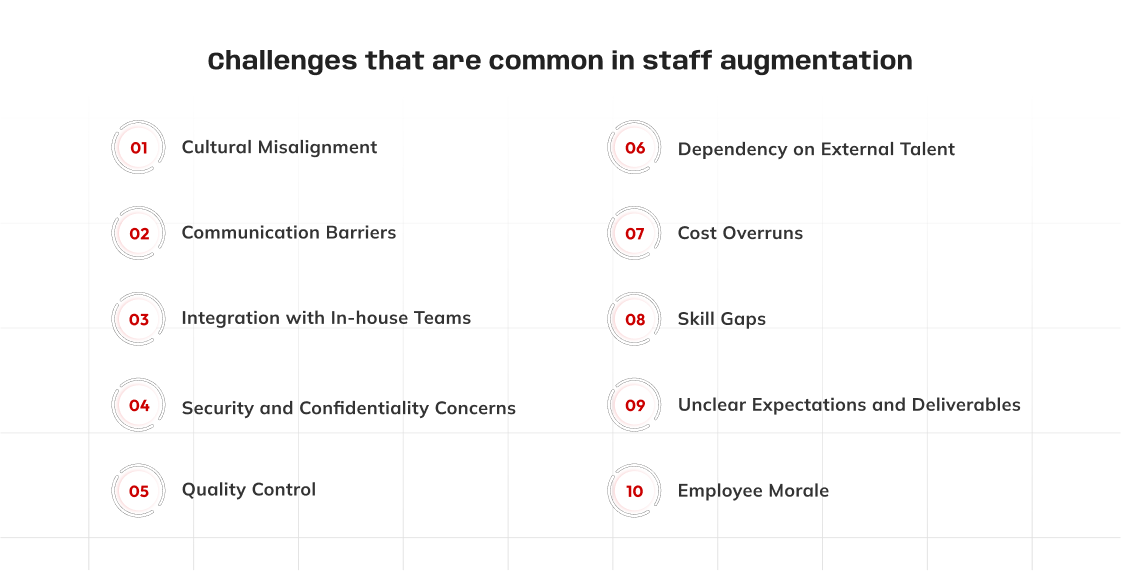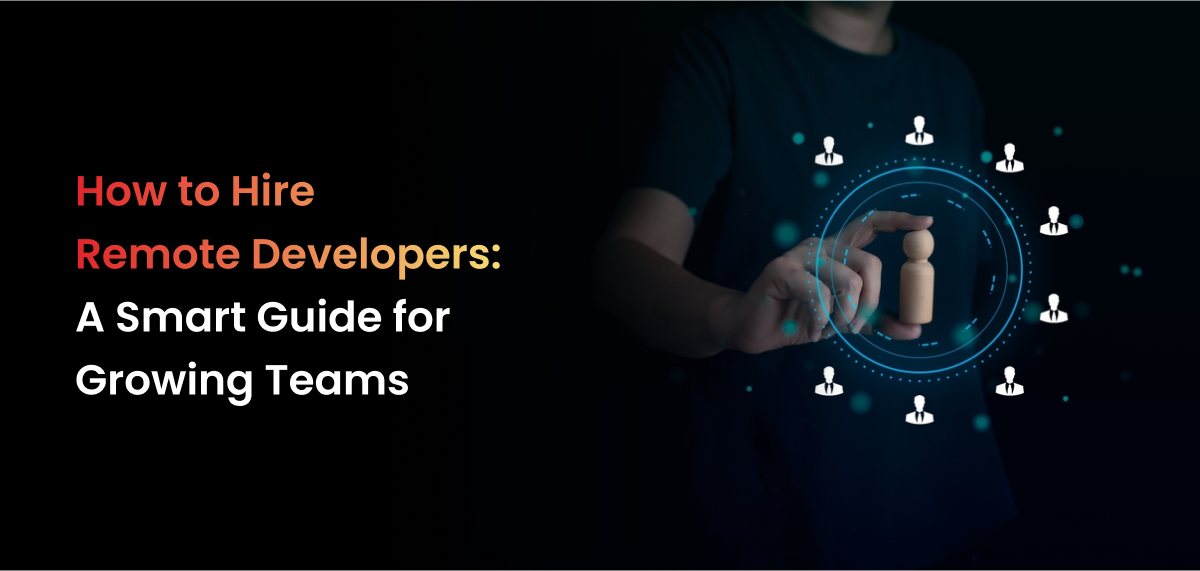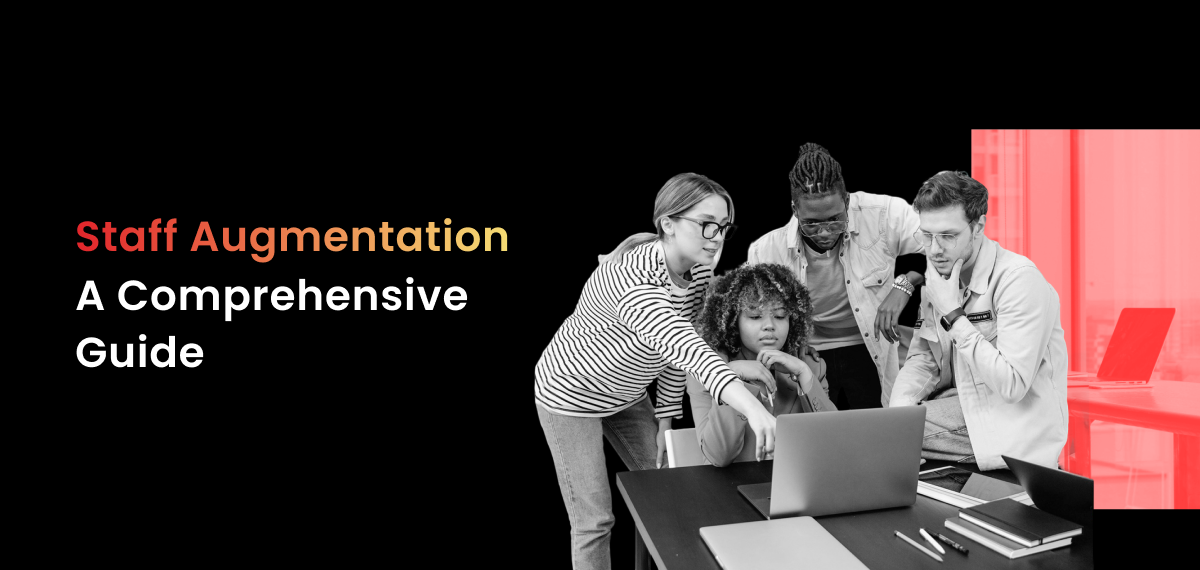Over the past few years, staff augmentation has proven to be one of the most preferred methods for organizations intending to increase their workforce, especially in the IT and tech industries. It’s flexible and cost-effective and there is a large pool of talent around the world to source from.
Nonetheless, it has its own set of shortcomings just like any other staffing strategy. These obstacles can have adverse effects not only on the effectiveness of the task at hand but also on the morale of the external team as well as the internal team.
This article aims to identify the challenges that are common in staff augmentation and suggest measures that can be taken to avert them.
Challenges That Are Common in Staff Augmentation

Cultural Misalignment
Challenge:
Although staff augmentation has many benefits, one of the key issues faced by organizations, in particularly with offshoring, is cultural differences. Each country or region usually has its own work ethic, communication styles, and business practices.
When such differences exist, there is always a risk of the parties not being on the same page in terms of expectations and method of work, and this can lead to dissatisfaction from either side.
Solution:
Allocate adequate time for cultural integration for the existing staff and the augmented recruits. Organize workshops on the appreciation of cultural diversity, the preferred ways of communication, and business practices. Support teamwork and effective communication to overcome any barriers.
Applications such as Slack or Microsoft Team will enable constant interaction and keep both parties on the same page regarding the objectives of the project.
Communication Barriers
Challenge:
There can be hurdles to effective communication owing to language barriers or due to the nature of working from remote locations. Inaccuracies in translation or ambiguity can delay engagement in the project and even lead to expensive errors.
Coordinating the work of a team that is located on different continents is not easy, especially when a factor of time difference is considered.
Solution:
When expanding your team, make sure that language skills are considered one of the hiring attributes, more so for positions which will require a lot of interaction with stakeholders. To help avoid differences in time zones, set out specific communication expectations such as setting up a daily or even weekly meeting through technology at agreed-upon times.
Employ tools such as Trello, Asana or, Jira and ensure all files are properly uploaded and communication fixed to eliminate the possibility of any conflicts in understanding.
Integration with In-house Teams
Challenge:
The combination of in-house teams with augmented staff can sometimes prove to be a challenge. Synergy, or the lack thereof, between the groups, may decrease productivity levels, where some members feel like second-class citizens, which in turn diminishes their motivation and commitment.
Solution:
Encourage a team-based environment where the extended workforce is integrated into the internal teams. Plan for several joint outreach activities (including but not limited to, meetings, virtual fun activities, and training). Assign and clarify team members’ specific duties and functions from the beginning to eliminate overlap of duties and ambiguity about accountability.
Security and Confidentiality Concerns
Challenge:
Delegating certain business responsibilities or IT operations to a third party adds security risks. There is always the prospect of a data breach or compromise of sensitive information. Local laws and international provisions are also important, and there is the difficulty of giving accompanying personnel the same degree of compliance smartly.
Solution:
Data security measures should be introduced immediately. All supplementary personnel should sign non-disclosure agreements. Conduct refresher training sessions periodically and implement segregation of duty for data that is highly sensitive.
It is equally important to partner with a qualified staffing company that has good security practices. Compliance with standards will be maintained through periodic assessments and reviews conducted during the engagement.
Quality Control
Challenge:
Quality assurance about work carried out by outsourced staff however, has its challenges, especially where such staff members are working from different geographical locations. There may be variations in the level of capability, attention to detail, and compliance with the standards set by the organization, which in turn may result in reduced productivity or quality concerns.
Solution:
Formulate and implement an ambitious quality control strategy. Making regular evaluations and feedback cycles will ensure the quality level of the output is retained. Progress and the quality of the work will also be measured based on the use of metrics known as key performance indicators (KPIs).
Also, communicate parameters and expectations in advance and guarantee that the outsourced team is provided with similar tools and resources as the in-house staff.
Dependency on External Talent
Challenge:
There is a danger in augmenting a staff too much as an over-reliance on external talent will create a dependency. Such a situation is highly unhealthy since it can suppress internal capacity building or, in worst cases, create a vacuum of knowledge in the organization once the externally introduced talent is gone.
Solution:
While maximizing the efficiency of augmented personnel, it is equally important to concentrate on nurturing the internally available talents. Fostering an exchange of skills & knowledge between augmented and internal teams is a must. It is essential to have procedures and key activities documented in a way that is familiar to the internal teams in case of having to take on those responsibilities.
Additionally, a gradual transition process can be introduced to transfer responsibilities from the outsourced teams to the in-house teams, depending on the individuals’ knowledge and experience.
Cost Overruns
Challenge:
Even though staff augmentation is popularly considered a cost-effective substitute for increasing internal resources, the out-of-pocket expenses could exceed the original limitation because of delayed delivery, optimistic belief or materials overload. Such factors can easily counter the advantages of this model economically.
Solution:
Outline the work at hand covered before bringing in extra manpower to prevent cost overruns. Have a thorough agreement detailing the project’s objective, deadlines, and expenses. Employ project management systems to monitor the advancement and financial plan, and periodically assess the stage of the project to make sure it is completed within the budget.
Skill Gaps
Challenge:
At times, the additional staff may lack the specific abilities for the task, which can lead to a delay in completion or poor quality of work. This is especially true where organizations haste in the recruitment process or do not correctly identify the skills needed for the assignment.
Solution:
Before making final decisions, make sure you have performed all the necessary background checks. Also, verify that the additional staff you hire have suitable qualifications and experience for that particular project.
It can be a great idea to consider hiring industry-specific recruitment agencies so that you can attract the best talent available. Lastly, ongoing education and skill development can help bridge any shortfalls that may arise in the course of the project.
Unclear Expectations and Deliverables
Challenge:
Confusion about the requirements or deliverables and frustration on both ends is a common scenario. The augmented staff may not fully grasp what is needed and the internal team may suffer from disappointment because of the work done.
Solution:
At the onset of the engagement, specific and quantifiable goals and outcomes must be established. Producing comprehensive documentation detailing the various responsibilities along with their corresponding timelines and benchmarks for success is necessary. In addition, having regular interactions would serve to keep everyone on the same wavelength and avoid any possible confusion from becoming problem.
Employee Morale
Challenge:
At times when a firm incorporates additional agency staff into its setup, it tends to lower the morale of the existing employees. This is because such employees might feel threatened regarding their job security or think that the organization regards external human resources more than the existing ones.
As a result, this causes ill feelings, a decline in productivity, and sometimes, even more staff deciding to leave their jobs than previously before.
Solution:
Make sure your in-house team understands why you need staff augmentation and its overall benefits to the business strategy. Help them understand that the augmented staff is there to assist them and not replace them. Address their career growth, skill development, and engagement to keep them motivated internally.
Conclusion
Staff augmentation comes on the benefits on many fronts but one has to be ready to tackle whatever challenges this comes with. Organizations that manage to overcome cross-cultural, communicational, and organizational barriers can realize the full capacity of augmented teams. In a cooperative and open working environment, the in-house meant to speak with augmented members will be more productive.
Braincuber is recognized as one of the top staff augmentation service providers in the industry. In addition, it strives to assist every company in conquering such challenges. We have successfully delivered high-quality talent time and again, feeding them into existing infrastructures without a hitch.
That is why Braincuber is ready to provide solutions that match your business, its circumstances and needs. Whether you are growing for a one-off assignment, or looking for additional long-term resources, with Braincuber, you can be sure you will always be able to deal comfortably with the challenges posed by modern workforce management.
Frequently Asked Questions (FAQs)
1. What are the most common staff augmentation challenges organizations face?
The most common staff augmentation challenges include cultural misalignment, communication barriers, integration difficulties, security concerns, and quality control issues. Other challenges include dependency on external talent, cost overruns, unclear expectations, and impacts on employee morale.
2. How can companies overcome cultural differences when using staff augmentation?
Companies can overcome cultural differences by investing in cultural integration workshops, setting clear communication protocols, organizing team-building activities, and defining explicit collaboration methods. These practices help create a more cohesive working environment.
3. What security measures should be implemented when using augmented staff?
Organizations should require NDAs, enforce strict data access controls, provide security training, and use secure VPN-based communication. Partnering with vetted agencies and conducting regular audits ensures compliance and data protection.
4. How can businesses prevent cost overruns in staff augmentation projects?
Prevent cost overruns by defining project scope clearly, using project management tools to monitor expenses, conducting milestone reviews, and setting budget contingencies. Implementing a structured change management process helps control additional costs.
5. How can organizations maintain employee morale when introducing augmented staff?
Employee morale can be preserved through transparent communication, emphasizing augmentation as support, offering development programs, and involving employees in onboarding processes. Recognition and feedback programs also strengthen morale and collaboration.















